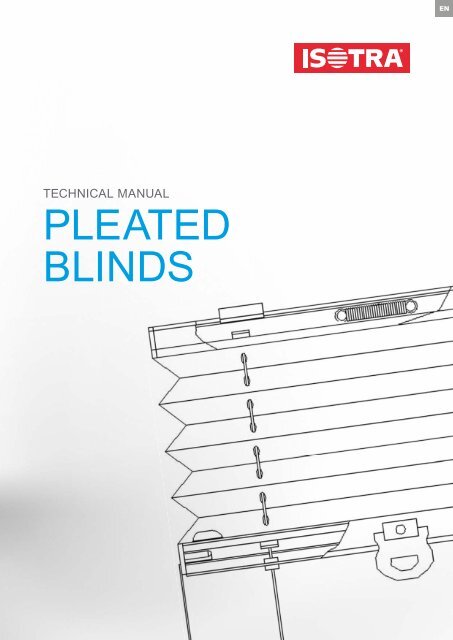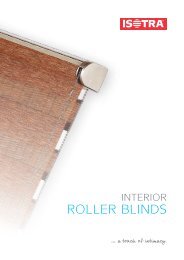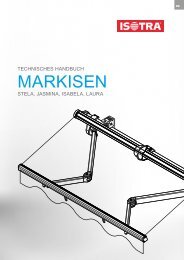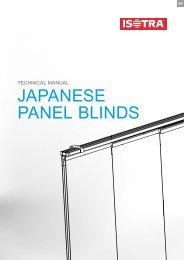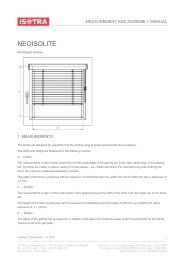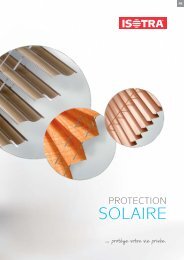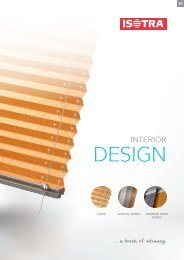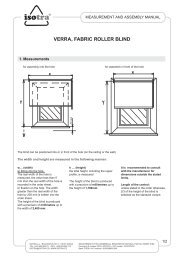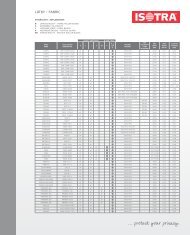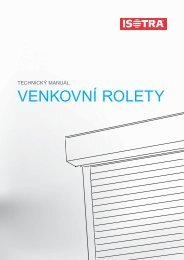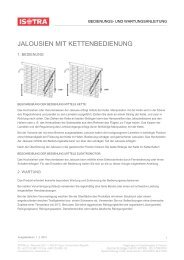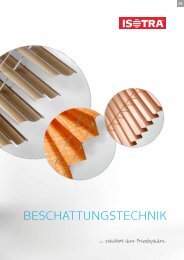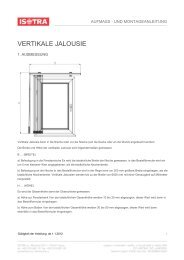Technical manual - Isotra
Technical manual - Isotra
Technical manual - Isotra
You also want an ePaper? Increase the reach of your titles
YUMPU automatically turns print PDFs into web optimized ePapers that Google loves.
EN EN<br />
TECHNICAL MANUAL<br />
PLEATED<br />
BLINDS
Table of Contents – Pleated Blind<br />
Basic Product Specification 4 - 5<br />
List of Types 6 - 12<br />
Types of Fixation 12<br />
Measuring Instructions 13 - 14<br />
Installation Instructions 15 - 17<br />
Safety features according to the standards EN 13120+A1; EN 16 433; EN 16 434 18<br />
A brand symbolizing years of tradition, innumerable investments into research and development, use of<br />
high-quality materials, technological advancement, reliable work of hundreds of employees and many<br />
more parameters, which together form one whole-the final product of the company ISOTRA.<br />
2
PLEATED BLINDS<br />
Pleated Blinds<br />
▲ Elegant element of modern interior<br />
▲ Many atypical shapes<br />
▲ Wide range of pleated materials, colors, patterns and<br />
printing<br />
▲ Fabrics with various light permeability, black-out fabrics,<br />
reflective fabrics and PERL fabrics<br />
▲ Optional combination of two fabrics<br />
▲ Variable control system – cord, handle<br />
3
Pleated Blind without Guidance (AO type) – Fixed Head Rail<br />
Basic Product Specification<br />
Head rail<br />
Cord<br />
Bottom rail<br />
Pleated Blind with Cord Guidance (BB, BO types) – Loose Head and Bottom Rail<br />
(optionally fixed head and bottom rail)<br />
Head rail<br />
Handle<br />
Bottom rail<br />
4
PLEATED BLINDS<br />
Pleated Blind with Steel Wire Guidance (PB type) – Fixed Head and Bottom Rail<br />
(optionally fixed bottom rail)<br />
Head rail<br />
Handle<br />
Bottom rail<br />
Sections of head and bottom rail<br />
Head and bottom rail<br />
Head, bottom and central rail<br />
Head and bottom rail<br />
Control<br />
Plastic handle or cord with integrated brake – for pulling the pleated blind up and down<br />
Specification<br />
Head rail Bottom rail Side Guidance Fabric Type Types of Fixation Installation<br />
Material Al Al without guidance (AO, AB<br />
types)<br />
cord ø 0.8 mm (BB, BO,<br />
types)<br />
steel wire ø 0.9 mm (PB type)<br />
Color<br />
RAL 9016 white<br />
RAL 8017 brown<br />
elox<br />
We make atypical designs.<br />
RAL 9016 white<br />
RAL 8017 brown<br />
elox<br />
according to current <strong>Isotra</strong> a.s.<br />
scheme alternatives:<br />
• pleated blind with one fabric<br />
• pleated blind with two fabrics<br />
in the wing CA<br />
on the wing<br />
• CB (40 mm)<br />
• CC (60 mm)<br />
• BV on the wing without drilling<br />
RAL 9016 white<br />
RAL 8017 brown<br />
elox<br />
in window aperture (ceiling)<br />
on window wing<br />
on perpendicular glazing rail<br />
before window aperture (wall)<br />
Standard Dimensions Minimum Width (mm) Maximum Width (mm) Maximum Height (mm)<br />
based on pleated blind type based on pleated blind type based on pleated blind type<br />
5
List of Types<br />
PLA Pleated Blind Type – floppy pleated blind, without guidance<br />
A<br />
H<br />
H<br />
AO 10<br />
Floppy pleated blind without guidance with fixed head rail<br />
Control with cord and brake<br />
Movement: roll at the upper profile<br />
Only for designs with window inclination of 90°<br />
Dimensions A,C(H) are used<br />
A<br />
<strong>Technical</strong> Data Width A Height C=H<br />
min max min max<br />
350 1900 / 1500* 300 2500<br />
* max. width for fabrics “black out”<br />
H<br />
A<br />
H<br />
AO 20<br />
Floppy pleated blind without guidance with fixed head rail<br />
Control with 2 cords and 2 brakes, vertical control<br />
Movement: roll in aribtrary position<br />
Only for designs with window inclination of 90°<br />
Dimensions A,C(H) are used<br />
<strong>Technical</strong> Data Width A Height C=H<br />
min max min max<br />
400 1900 / 1500* 300 2500<br />
* max. width for fabrics “black out”<br />
A<br />
B<br />
D<br />
AO 40<br />
Floppy pleated blind without guidance with fixed head rail<br />
Control with cord and brake, vertical control on shorter side<br />
Bevelled part portable together with the lower part<br />
Movement: roll at the bevelled upper profile<br />
Only for designs with window inclination of 90°<br />
Dimensions A,B,C,D(H) are used<br />
C<br />
<strong>Technical</strong> Data Width A Height D=H<br />
min max min max<br />
400 1900 / 1500* 500 2500<br />
* max. width for fabrics “black out”<br />
A<br />
B<br />
A<br />
D<br />
AO 70<br />
Floppy pleated blind without guidance with fixed head rail<br />
Control with cord and brake, vertical control on longer side<br />
Movement: roll at the bevelled upper profile<br />
Only for designs with window inclination of 90°<br />
Dimensions A,B,D(H) or A,B,C(H) are used<br />
<strong>Technical</strong> Data Width A Height D=H<br />
min max min max<br />
400 1900 / 1500* 300 2500<br />
* max. width for fabrics “black out”<br />
A<br />
H<br />
AB 10<br />
Arc pleated blind with fixed half of bottom rail<br />
Manual control, handle<br />
For designs with window inclination of 90°<br />
If A/2 does not equal H, it is a fixed design, and a template needs to be supplied for production.<br />
This type can be turned by 180 degrees.<br />
Dimensions A,H are used<br />
<strong>Technical</strong> Data Width A Height H<br />
min max min max<br />
400 1200 200 600<br />
6
PLEATED BLINDS<br />
List of Types<br />
PLB Pleated Blind Type – blind type with cord guidance<br />
H<br />
A<br />
H<br />
BO 10<br />
Pleated blind with cord guidance with fixed head rail<br />
Control with cord and brake, vertical control<br />
Movement: roll at the upper profile<br />
Only for designs with window inclination of 75 - 90°<br />
Dimensions A,C(H) are used<br />
<strong>Technical</strong> Data Width A Height C=H<br />
min max min max<br />
400 1300 300 2500<br />
A<br />
H<br />
A<br />
H<br />
BO 16<br />
Pleated blind with cord guidance with fixed head and bottom rail<br />
Control with cord and brake, vertical control<br />
Movement: roll at the lower profile<br />
Only for designs with window inclination of 75 - 90°<br />
Dimensions A,C(H) are used<br />
<strong>Technical</strong> Data Width A Height C=H<br />
min max min max<br />
400 1300 300 2500<br />
A<br />
A<br />
H<br />
H<br />
BO 20<br />
Pleated blind with cord guidance with fixed head rail<br />
Control with 2 cords and 2 brakes, vertical control<br />
Movement: roll in arbitrary position<br />
Only for designs with window inclination of 75 - 90°<br />
Dimensions A,C(H) are used<br />
<strong>Technical</strong> Data Width A Height C=H<br />
A<br />
min max min max<br />
400 1300 300 2500<br />
B<br />
C<br />
D<br />
BO 60<br />
Pleated blind with cord guidance with fixed head and bottom rail<br />
Control with cord and brake, vertical control<br />
Movement:roll at the lower profile<br />
Only for designs with window inclination of 75 - 90°<br />
Dimensions A,B,C(H),D are used<br />
<strong>Technical</strong> Data Width A Height C=H<br />
min max min max<br />
400 1300 300 2500<br />
A<br />
C<br />
B<br />
D<br />
BO 61<br />
Pleated blind with cord guidance with fixed head and bottom rail<br />
Control with cord and brake, vertical control<br />
Maximum diff erences between B and A = 100 mm<br />
Movement: roll at the lower profile<br />
Only for designs with window inclination of 75 - 90°<br />
Dimensions A,B,C,D(H) are used<br />
<strong>Technical</strong> Data Width A Height H<br />
min max min max<br />
400 1300 300 2500<br />
A<br />
7
List of Types<br />
PLB Pleated Blind Type – blind type with cord guidance<br />
C<br />
B<br />
A<br />
BO 75<br />
Pleated blind with cord guidance with fixed head and bottom rail<br />
Control with cord and brake, vertical control<br />
Maximum declination is 60°<br />
Movement: roll at the lower profile<br />
Only for designs with window inclination of 75 - 90°<br />
Dimensions A,B,C(H) or A,B,D(H) are used<br />
<strong>Technical</strong> Data Width A Height C=H<br />
min max min max<br />
400 1300 300 2500<br />
H<br />
A<br />
H<br />
BB 10<br />
Pleated blind with cord guidance with fixed head rail<br />
Manual control, handle<br />
Movement: roll at the upper profile<br />
Only for designs with window inclination of 75 - 90°<br />
This type can be turned by 180 degrees<br />
Dimensions A,C(H) are used<br />
<strong>Technical</strong> Data Width A Height C=H<br />
A<br />
min max min max<br />
150 1500 300 2200<br />
H<br />
A<br />
H<br />
BB 20<br />
Pleated blind with cord guidance with fixed head rail<br />
Manual control, handle<br />
Movement: roll in the arbitrary position<br />
Only for designs with window inclination of 75 - 90°<br />
This type can be turned by 180 degrees<br />
Dimensions A,C(H) are used<br />
<strong>Technical</strong> Data Width A Height C=H<br />
min max min max<br />
150 1500 300 2200<br />
A<br />
H<br />
A<br />
H<br />
BB 24<br />
Pleated blind with cord guidance without head and bottom rail<br />
Manual control, handle<br />
Movement: roll in the arbitrary position<br />
Only for designs with window inclination of 75 - 90°<br />
This type can be turned by 180 degrees<br />
Dimensions A,C(H) are used<br />
<strong>Technical</strong> Data Width A Height C=H<br />
min max min max<br />
300 1300 300 2200<br />
C<br />
B<br />
A<br />
B1<br />
D<br />
BB 80<br />
Pleated blind with cord guidance with fixed bottom rail<br />
Manual control, handles<br />
Minimum upper width = 150 mm<br />
Maximum difference between B and A = 600 mm<br />
Movement: roll at the lower profile<br />
Only for designs with window inclination of 75 - 90°<br />
This type can be turned by 180 degrees<br />
Dimensions A,B,B1,C,D(H) are used<br />
A<br />
<strong>Technical</strong> Data Width A Height D=H<br />
min max min max<br />
300 1500 300 2200<br />
8
PLEATED BLINDS<br />
List of Types<br />
PLB Pleated Blind Type – pleated blind with cord guidance<br />
C<br />
B<br />
B1<br />
B2<br />
D<br />
BB 81<br />
Pleated blind with cord guidance with fixed bottom rail<br />
Manual control, handles<br />
Minimum upper width = 150 mm<br />
Maximum difference between B1 and A = 1200 mm<br />
Movement: roll at the lower profile<br />
Only for designs with window inclination of 75 - 90°<br />
This type can be turned by 180 degrees<br />
Dimensions A,B,B1,B2,C,D,H are used<br />
<strong>Technical</strong> Data Width A Height H<br />
A<br />
min max min max<br />
450 1500 300 2200<br />
H<br />
A<br />
H<br />
BB 10T<br />
Pleated blind with cord guidance with fixed head and bottom rail<br />
Manual control, handle<br />
Movement: roll at the upper profile<br />
Only for designs with window inclination of 75 - 90°<br />
This type can be turned by 180 degrees<br />
Dimensions A,C(H) are used<br />
<strong>Technical</strong> Data Width A Height C=H<br />
A<br />
min max min max<br />
150 1500 300 2200<br />
A<br />
H<br />
H<br />
BB 20T<br />
Pleated blind with cord guidance with fixed head and bottom rail<br />
Manual control, handle<br />
Movement: roll in arbitrary position<br />
Only for designs with window inclination of 75 - 90°<br />
This type can be turned by 180 degrees<br />
Dimensions A,C(H) are used<br />
<strong>Technical</strong> Data Width A Height C=H<br />
min max min max<br />
150 1500 300 2200<br />
A<br />
List of Types<br />
PLP Pleated Blind Type – pleated blind with steel wire guidance<br />
H<br />
A<br />
H<br />
PB 10<br />
Pleated blind with steel wire guidance with fixed head and bottom rail<br />
Manual control, handle or wand<br />
Movement: roll at the upper profile<br />
For designs with window inclination of 0 - 90°<br />
This type can be turned by 180 degrees<br />
Dimensions A,C(H) are used<br />
<strong>Technical</strong> Data Width A Height C=H<br />
min max min max<br />
150 1500 300 2200<br />
A<br />
9
C<br />
B<br />
D<br />
PB 60<br />
Pleated blind with steel wire guidance with fixed bottom rail<br />
Manual control, handle or wand<br />
Minimum upper width = 150 mm<br />
Maximum difference between B and A = 600 mm<br />
Movement: roll at the lower profile<br />
For designs with window inclination of 0 - 90°<br />
This type can be turned by 180 degrees<br />
Dimensions A,B,C,(H)D are used<br />
<strong>Technical</strong> Data Width A Height C=H<br />
min max min max<br />
300 1500 300 2200<br />
A<br />
C<br />
B<br />
D<br />
PB 61<br />
Pleated blind with steel wire guidance with fixed bottom rail<br />
Manual control, handle or wand<br />
Minumum upper width = 150 mm<br />
Maximum difference between B and A = 1200 mm<br />
Movement: roll at the lower profile<br />
For designs with window inclination of 0 - 90°<br />
This type can be turned by 180 degrees<br />
Dimensions A,B,C,D,H are used<br />
<strong>Technical</strong> Data Width A Height C=H<br />
min max min max<br />
450 1500 300 2200<br />
A<br />
C<br />
B<br />
B1<br />
D<br />
PB 80<br />
Pleated blind with steel wire guidance with fixed bottom rail<br />
Manual control, handle or wand<br />
Minimum upper width = 150 mm<br />
Maximum difference between B1 and A = 600 mm<br />
Movement: roll at the lower profile<br />
For designs with window inclination of 0 - 90°<br />
This type can be turned by 180 degrees<br />
Dimensions A,B,B1,C,D(H) are used<br />
<strong>Technical</strong> Data Width A Height D=H<br />
min max min max<br />
300 1500 300 2200<br />
A<br />
C<br />
B<br />
B1<br />
B2<br />
D<br />
PB 81<br />
Pleated blind with steel wire guidance with fixed bottom rail<br />
Manual control, handle or wand<br />
Minimum upper width = 150 mm<br />
Maximum difference between B1 and A = 1200 mm<br />
Movement: roll at the lower profile<br />
For designs with window inclination of 0 - 90°<br />
This type can be turned by 180 degrees<br />
Dimensions A,B,B1,B2,C,D,H are used<br />
<strong>Technical</strong> Data Width A Height H<br />
min max min max<br />
450 1500 300 2200<br />
10
PLEATED BLINDS<br />
List of Types<br />
PL2 Pleated Blind Type – pleated blind with two different fabrics<br />
H<br />
A<br />
H<br />
BO 30<br />
Pleated blind with cord guidance with fixed head rail<br />
Control with 2 cords and 2 brakes<br />
2 diff erent types of fabric<br />
Movement: roll at the upper profile<br />
Only for designs with window inclination of 75 - 90<br />
Dimensions A,C(H) are used<br />
<strong>Technical</strong> Data Width A Height C=H<br />
min max min max<br />
400 1300 300 2500<br />
A<br />
H<br />
A<br />
H<br />
BO 35<br />
Pleated blind with cord guidance with fixed head and bottom rail<br />
Control with 2 cords and 2 brakes<br />
2 different types of fabrics<br />
Movement: roll at the lower profile<br />
Only for designs with window inclination of 75 - 90°<br />
Dimensions A,C(H) are used<br />
<strong>Technical</strong> Data Width A Height C=H<br />
min max min max<br />
400 1300 300 2500<br />
A<br />
H<br />
A<br />
H<br />
BB 30<br />
Pleated blind with cord guidance with fixed head rail<br />
Manual control, handles<br />
2 different types of fabric<br />
Movement: roll at the upper profile<br />
Only for designs with window inclination of 75 - 90°<br />
This type can be turned by 180 degrees<br />
Dimensions A,C(H) are used<br />
<strong>Technical</strong> Data Width A Height C=H<br />
A<br />
min max min max<br />
300 1500 300 2200<br />
H<br />
A<br />
H<br />
BB 30T<br />
Pleated blind with cord guidance with fixed head and bottom rail<br />
Manual control, handles<br />
2 different types of fabric<br />
Movement: roll at the upper profile<br />
Only for designs with window inclination of 75 - 90°<br />
This type can be turned by 180 degrees<br />
Dimensions A,C(H) are used<br />
<strong>Technical</strong> Data Width A Height C=H<br />
A<br />
min max min max<br />
150 1500 300 2200<br />
11
H<br />
A<br />
H<br />
PB 30<br />
Pleated blind with steel wire guidance with fixed head and bottom rail<br />
Manual control, handle or wand<br />
2 different types of fabrics<br />
Movement: roll at the upper profile<br />
For designs with window inclination of 0 - 90°<br />
This type can be turned by 180 degrees<br />
Dimensions A,C(H) are used<br />
<strong>Technical</strong> Data Width A Height C=H<br />
min max min max<br />
150 1500 300 2200<br />
A<br />
Types AO40, AO70, AB10, BO61, BO75, BB80, BB81, PB60, PB61, PB80, PB81 can´t by produced with fabric Honeycomb.<br />
Types of Fixation<br />
CC - fixation on the wing (60 mm)<br />
CB - fixation on the wing (40 mm)<br />
CA - fixation to the wing<br />
BV - fixation on the wing without drilling<br />
12
PLEATED BLINDS<br />
Pleated Blind<br />
MEASUREMENT OF PLEATED BLIND FOR RECTANGULAR WINDOWS<br />
Assembly to the window wing<br />
A<br />
PLEATED BLIND HEIGHT<br />
PLEATED BLIND WIDTH<br />
Recommendation: The minimum measured width minus 2 mm from each side = the width of the calculation of the price<br />
A<br />
Note: Minimum depth<br />
of the glazing bar = 25 mm<br />
Assembly on the front window wall on the window wing<br />
A<br />
PLEATED BLIND HEIGHT<br />
PLEATED BLIND WIDTH<br />
A<br />
Recommendation: The excess of the pleated blind on each side is approximately 20 mm (to the expanded hande)<br />
Note: Take the expanding part of the window<br />
(e.g. handle) into consideration<br />
ORDERING DIMENSIONS (DIMENSIONS OF FINISHED PLISSE):<br />
Width (mm) = width clearance of the hole in the window width<br />
Height (mm) = height clearance of the hole in the window wing<br />
13
MEASUREMENT OF PLEATED BLIND FOR UNTYPICAL WINDOWS<br />
Basic dimensions are the dimensions of the product.<br />
If H ≠ ½ A, it is necessary<br />
to supply a template<br />
A = basic width, design<br />
B = upper width, it can consist of three various dimensions … i.e. B, B1, B2<br />
C = left height<br />
D = right height<br />
H = basic height, design (perpendicular to base A)<br />
All these dimensions, if they are, are measured closely at the glass from the left inside edge of the glazing bar to the right inside edge of the<br />
glazing bar, including the rubber or silicon sealing in three places – upwards, in the middle and downwards. For manufacturing and ordering<br />
the pleated blind, the minimum measured dimension is stated. The width and height of the pleated blind are produced with a precision<br />
of millimetres from the width according to the type (see below) with the tolerance ± 1 mm.<br />
If the shape is reverse and one is able to turn the pleated blind (see below), write the dimensions into the order according to the upper<br />
figure. The pleated blind is produced in the same manner; the assembly is in the opposite manner. This is reflected in the notes!<br />
THE MANUFACTURER SHOULD BE CONSULTED FOR DIMENSIONS OUTSIDE THE STATED LIMITS.<br />
If the pleated blind is assembled in a manner other than in the case of the glazing bars (i.e. on the face of the wing), it will again be produced<br />
exactly according to the order form. In all cases the product will be produced exactly according to the order.<br />
Minimum and maximum manufacturing dimensions – according to individual types.<br />
ATTENTION! WHEN MEASURING, CHECK THE SHAPE AND SIZE OF THE GLAZING BAR TO PREVENT ANY PROBLEMS DURING THE ASSEMBLY<br />
OF THE GUIDING (TIGHTENING OR CORDS).<br />
14
PLEATED BLINDS<br />
ASSEMBLY<br />
Assemble exactly according to this <strong>manual</strong> to prevent redundant assembly errors and other related problems.<br />
AIDS FOR ASSEMBLY:<br />
• tape measure<br />
• pencil<br />
• drills<br />
• accumulator drilling machine<br />
• magnetic adapter, bits PZ2,PZ1<br />
• knife, scissors, pliers<br />
for the fixation of the pleated blind<br />
hole for tightening units of cords<br />
screw 3,5 x 16 3,5x9,5<br />
drill with the diameter Ø 2 mm 2 mm<br />
INSPECTION:<br />
• Before assembly we recommend inspecting all the parts after the delivery of the goods to prevent any problems.<br />
Any defects or comments concerning the assembly or blinds must be notified to the manufacturer.<br />
ASSEMBLY<br />
• On the pleated blind in the window wing check that the dimension corresponds according to the width of the window.<br />
• Screw the clamps or clamp holders to the wing by means of screws; for plastic windows, if possible, only screw into the glazing bar to prevent<br />
damage of the window wing.<br />
• Attach the upper profile of the pleated blind into the clamps and spread the pleated blind, check the tightening of cords, ropes or length of<br />
the cords (according to the type), or modify the tightening force of the springs, lengths of cords.<br />
• Click the lower profile or screw the tightening units for the cords.<br />
• For models equipped with a control handle, set the correct angle of the handle (handles) for more comfortable control of the product.<br />
Notification: The handle can be set at several angles, according to the location and access to the product. This setting is done immediately<br />
after installation and it is recommended to not change the setting. If this condition is not maintained, there can be damage and devaluation<br />
to the handle.<br />
15
Installation<br />
ASSEMBLY IN FRONT OF THE WINDOW HOLE (ON THE WALL)<br />
version A – small console<br />
version B – large console<br />
Pleated blind width<br />
50-100<br />
14<br />
16<br />
Pleated blind height<br />
8<br />
22<br />
Pleated blind height<br />
2<br />
1<br />
2<br />
1<br />
Screw 3,5 x 16<br />
3<br />
4<br />
1<br />
3<br />
2<br />
1
PLEATED BLINDS<br />
Installation<br />
ASSEMBLY INTO THE WINDOW HOLE (CEILING), ON THE WINDOW WING, ON THE PERPENDICULAR GLAZING BAR<br />
11<br />
50-100<br />
1<br />
2<br />
If the shape or size of the glazing bar does not allow drilling holes for the tightening pins into the glazing bar<br />
from upwards, choose the option of drilling the holes for pins into the face of the glazing bar. With this option<br />
take care not to damage the glass with the drill. It is important to measure the correct depth of the drilling!<br />
The client must be informed in advance of this form of assembly and consent in writing in the handing over<br />
protocol. Finally, ensure the full functionality of the blind and the window.<br />
Installation<br />
Fixation on the wing<br />
without drilling<br />
17
Safety features according to the standards EN 13120+A1; EN 16 433; EN 16 434<br />
Connection Pulley Winch Two wheels<br />
Safe type of operation<br />
Dangerous operation<br />
Suitability of ISOTRA<br />
protective systems<br />
INTERIOR SHADING<br />
HORIZONTAL BLINDS<br />
ISOTRA SYSTEM HIT<br />
ISOTRA SYSTEM HIT II<br />
ISOTRA SYSTEM CLASSIC<br />
ISOTRA ENERGY<br />
ISOLITE<br />
ISOLITE PLUS<br />
NEOISOLITE<br />
SYSTEM 25S, 25SM<br />
SYSTEM 25R<br />
SYSTEM 25L (large)<br />
SYSTEM 25K<br />
SYSTEM 25SW<br />
SYSTEM 25M<br />
CETTA 35, 50 - ECONOMY<br />
CETTA 35<br />
CETTA 50 (usage in interior)<br />
WOODLITE 50<br />
V-LITE INTERIOR ROOF BLIND<br />
VERTICAL BLINDS<br />
JAPANESE PANEL BLINDS<br />
PLISSÉ<br />
Type AO<br />
Type AB<br />
Type BO<br />
Type BB<br />
Type PB<br />
FABRIC ROLLER BLINDS<br />
VERRA<br />
VERA METAL<br />
ROLLITE<br />
LUNA<br />
SUNLITE<br />
NEMO<br />
SHADING ROLLER BLIND<br />
R-LITE ROOF ROLLER BLIND<br />
Manually<br />
Wheel<br />
Handle<br />
Switch<br />
Remote control<br />
Strap<br />
Control bar<br />
Cord<br />
Cord/Rod<br />
Ball-chain<br />
Connection<br />
Pulley<br />
Winch<br />
Two wheels<br />
18
ISOTRA a.s.<br />
Bílovecká 2411/1, 746 01 Opava<br />
Czech Republic<br />
ISOTRA Partner<br />
Tel.: +420 553 685 111<br />
Fax: +420 553 685 110<br />
E-mail: isotra@isotra.cz<br />
www.isotra.cz<br />
9/2014


